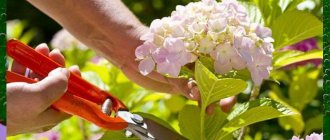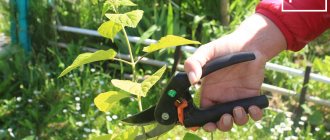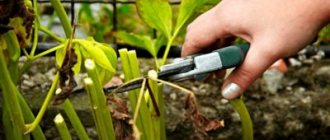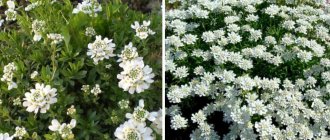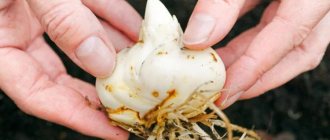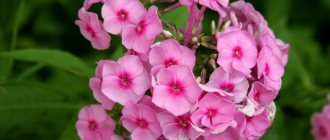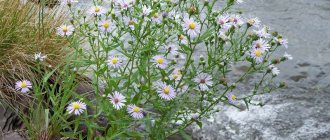Hydrangea (hydrangea) is a royal flower and a favorite of many gardeners. Its name is translated from Latin as “vessel of water.” And all because the plant loves water very much. Hydrangea does not require complicated care and delights with gorgeous blooms all summer long. The main thing in growing this plant is timely feeding and abundant watering. But in order for the inflorescences to be lush, hydrangeas need to be pruned in autumn and spring.
Blooming hydrangeas are beautiful in any area
Main types of garden hydrangeas with names and photos
This garden plant has several dozen different species, approximately 80 in total. But the most famous and widespread are only a few (photos and names of varieties are presented below). So, the most popular are:
- Tree-like − ornamental shrub with spectacular and lush inflorescences. Flowering period is from July to October. Easily tolerates harsh winter conditions. Grows well in both partial shade and sun. The plant forms new inflorescences on the current year's shoots. The most popular varieties of tree hydrangea: Annabelle, Pink Annabelle (you can see photos of these varieties of hydrangeas below).
- Paniculata is an incredible plant with gorgeous cone-like inflorescences. Inflorescences are divided into small (bisexual) and large (sterile). During flowering, paniculate hydrangea inflorescences can gradually change color from white to soft pink, and then to bright pink. A magical sight! New inflorescences form on the shoots of the current year. The most popular varieties of paniculate hydrangea are: “Pinky Winky”, “Bobo”, “Diamond Rouge” (photos of varieties are presented below). Varieties of beautiful hydrangea “Pinky Winky”, “Bobo”, “Diamond Rouge” will decorate any garden.
- Large-leaved (garden) - a gorgeous plant that can change the color of flowers. For example, a pink flower can turn blue or blue, and a red flower can turn purple. This occurs due to a decrease or increase in soil acidity. But large-leaved hydrangea with white inflorescences cannot be painted and does not change color. Inflorescences appear on last year's shoots. Therefore, if the shoots were cut off or frozen in winter, the hydrangea will not bloom. Large-leaved hydrangeas are pruned in the fall. The plant must be covered for the winter. This information is especially relevant for beginners. Because experienced gardeners know that large-leaved hydrangea is a very finicky plant. And it must be carefully looked after.
Paniculata hydrangea is the most winter-hardy plant species.
These types of hydrangeas are much less common:
- Oakleaf - this type of hydrangea is similar to paniculate inflorescences and has a delicate and subtle aroma. This is the main “highlight” of the plant. The leaves of oakleaf hydrangea are somewhat similar to oak leaves. They feel like velvet to the touch. There is one more feature. It lies in the fact that the leaves are bright green in summer, but with the onset of autumn they acquire a burgundy color, which looks very impressive in the garden. Unfortunately, this type of hydrangea is not common. But it must be said that it belongs to the frost-resistant species.
- Serrated - this hydrangea, like the large-leaved one, is capable of changing color due to the acidity of the soil. From soft blue to lilac. She needs shelter for the winter.
- Petiolate (garden vine) - this hydrangea can grow 20 meters in height.
- Sargenta - This plant blooms with beautiful pale purple flowers. The leaves are very large. For the winter, hydrangea must be covered.
Petiole hydrangea is able to absorb all nutrients not only through the root system, but also through aerial roots. But this plant is not particularly winter-hardy. The garden vine blooms with large white inflorescences. They emit a dizzying aroma that attracts insects.
Hydrangea has unusually beautiful flowering
There are varieties of large-leaved hydrangea that bloom twice: first on the shoots of the previous year, then on the shoots of the current year, for example, the varieties “Endless Summer”, “Liberteen”, “Fireworks Pink”. Therefore, such varieties are not afraid of spring pruning. You can see photos of the varieties below.
Favorite varieties of gardeners: “Endless Summer”, “Liberteen”, “Fireworks Pink”
Why do hydrangeas need to be pruned?
If the hydrangea is not pruned, then it will take on a neglected and ugly appearance. The inflorescences will become small and flowering will decrease. But thanks to pruning, the inflorescences will be large and lush. Main tasks when pruning:
- Plant rejuvenation.
- Crown formation.
- Pruning for powerful growth of new shoots.
- Thinning.
- Removing frozen and weak branches.
After spring rejuvenating pruning of hydrangea paniculata there will be few flowers, but they will be very large.
What tools are needed for pruning?
You need to be careful when choosing a tool so as not to injure the plant with an incorrectly selected pruner.
To carry out all types of pruning, it is enough to use ordinary garden pruning shears or garden shears. The choice of these tools depends on the height and variety of hydrangea. Before use, instruments are disinfected. A solution of potassium permanganate is suitable for this. Before pruning each new bush, the tool is dipped in a disinfecting solution to prevent infection by pathogenic microbes.
When to prune hydrangeas in spring and autumn - dates by month
For many gardeners, especially beginners, questions such as: when is the best time to prune hydrangeas? In autumn or spring? How to prune correctly? And in what months should it be carried out?
So, the main pruning of plants is carried out in early spring, after the snow has melted, but before the sap begins to flow, around the end of March. Large-leaved hydrangea does not need to be pruned in the spring, since new inflorescences grow from the upper buds. You can only do a little cosmetic pruning. Below you can watch a video for beginners on how to prune hydrangeas in the spring.
Instructions for those who do not know how to prune hydrangeas
Tree and paniculate hydrangeas can be pruned in both autumn and spring.
In autumn, old inflorescences, broken branches and shoots growing inside the crown of tree or paniculate hydrangea are usually carefully removed.
You can see how to properly prune hydrangeas in this video.
Caring for hydrangea in the fall and preparing for winter. In a special publication on our portal, we will talk in detail about how to care for hydrangeas in the autumn and how to properly prepare them for wintering; learn about caring for hydrangeas in the spring during the recovery period.
Timing for pruning
The exact timing of work with plants depends on the climate of the area and the prevailing weather. Many gardeners coordinate the timing of planting and pruning hydrangeas in the fall with the recommendations of the Lunar calendar.
Favorable days according to the Lunar calendar 2022
Favorable days for formative pruning:
- September: 3-6, 21-23, 26-28
- October: 9-11, 23-26
Favorable days for sanitary pruning:
- September: 3-8, 18-21, 23-28
- October: 5-7
- November: 4-8
Unfavorable days:
- September: 7, 21, 22
- October: 6, 7, 14-16, 20, 21
- November: 5, 11, 12, 19
- December: 4, 5, 8, 9, 19
Depending on the climate of the region
Young hydrangea bushes are not cut in the fall for a couple of years after planting, allowing the plants to get stronger. Only in early spring are shoots damaged by snow or frost removed.
Adult perennials begin to be pruned after leaf fall, when the branches are exposed to foliage and sap flow in the shoots slows down.
During the summer, it is necessary to cut off the faded caps of inflorescences in a timely manner, preventing the shrub from wasting energy on producing seeds.
Timing for pruning hydrangeas in autumn by region:
| Region | When to prune |
| Middle zone and Moscow region | Traditionally, the period from mid-September to early October is considered deciduous. At this time, before frost hits, work is being done to trim perennial bushes. |
| Leningrad region | Hydrangea is pruned in September |
| Ural and Siberia | The timing of pruning is compressed due to the short autumn and the early arrival of cold weather. The plant is trimmed in early September. In these regions, hydrangeas are not cut too short (it is enough to shorten the shoots by a third), otherwise, in short summer conditions, the shoots will not have time to set buds for flowering. |
| South | Pruning is carried out in October. |
| Ukraine, Belarus | The climate is mild, autumn is warm. Hydrangea is pruned in October. |
General rules and recommendations for pruning hydrangeas of different ages
Proper pruning will help give the plants the correct bush shape. The inflorescences will be large and beautiful. Here are the general rules:
- Hydrangea bushes are trimmed only with sharp and clean pruning shears, so as not to cause significant wounds to the plant.
- Under no circumstances should you cut off hydrangea branches.
- Last year's inflorescences and weak and frozen branches should be trimmed in good weather. But it is advisable to do this before the sap flow begins. For example, in October or March. At this time, the plant is dormant.
- Do not leave split stumps or cuts. Otherwise, the plant may die. Be sure to treat such areas with garden varnish or its substitute.
- Thick branches of the bush need to be cut down with a hacksaw. Make sure that the edges of the cut are smooth. And also treat them with garden varnish.
- The cut should be made obliquely, at a distance of 2-3 centimeters from the buds.
- Cuts and any damage on large branches must be covered with garden varnish or some kind of substitute.
- If the hydrangea bush is large, then you need to prune the branches gradually, over 2-3 years. Otherwise, the hydrangea may die.
By following these rules in spring and fall, you can enjoy abundant hydrangea blooms all summer long.
Blooming hydrangea is an unforgettable sight
How to prune hydrangeas to form the crown of young plants
During the first 2-3 years, it is imperative to form the crown of a young plant.
To do this, it is necessary to take into account species characteristics. For example, in a large-leaved plant, as mentioned earlier, you only need to cut off the faded inflorescences, without touching the new non-flowering shoots. Paniculata can be formed into a tree. You only need to remove weak (null) branches growing from the root and shoots growing inside the bush. Strong shoots must be shortened by 1-2 buds, because the stronger the hydrangea branch, the more buds can be left on it. But if you want to form a bush, then when planting you need to deepen the hydrangea a little. After some time, new shoots will appear.
In young tree-like plants, the shoots need to be shortened just a little in the first year. It is necessary to remove diseased and frozen branches. This is done so as not to interfere with the adaptation of the plant and the growth of a powerful root mass. In the second season, the shoots are shortened and 3-4 buds are left on the branch. It is necessary to begin to form the skeletal basis of the plant in the second year.
How to prune mature hydrangeas to stimulate vigorous flowering
In mature hydrangeas, as a rule, flowering may decrease. The once lush and luxurious inflorescences become smaller and are no longer pleasing to the eye. This problem can be solved using the same pruning.
- It is necessary to remove last year's old shoots, leaving only 2 or 3 buds. New shoots will then grow in this place with powerful flowering.
- Don't forget about dry and frozen branches. You need to get rid of them too.
- To ensure that the plant has enough light, prune thickening branches and branches growing inside the bush.
- Old shoots growing from the roots can be carefully removed to the base.
After these events, hydrangea will begin to bloom beautifully again
How to perform radical pruning to rejuvenate old or diseased plants
Old or disease-damaged hydrangea bushes can be rejuvenated. To do this you just need to do some radical pruning. In this case, the plant is cut down to the stump, removing old, large shoots (just do this with a hacksaw. And do not forget to cover the cuts with garden varnish). But fresh shoots must be left.
Radical pruning of large-leaved hydrangea in the spring will help restore the plant to its former beauty. True, the disadvantage of such pruning is that after it the plant may not bloom for one season. But don't panic. After all, this happens due to the fact that the plant forms a healthy and strong crown. In a year, lush and large inflorescences will appear again.
How to feed hydrangea in the fall after pruning
In autumn, the gardener’s main task in caring for perennials is to prepare the plant for winter. Proper feeding plays an important role in the successful wintering of hydrangea.
Phosphorus-potassium fertilizers are used, which promote better ripening of wood and root systems.
Attention! Nitrogen fertilizers that promote the growth of green mass cannot be applied in the fall!
It is convenient for a novice gardener to purchase ready-made mineral fertilizer complexes, especially for autumn feeding of hydrangea. For example:
- Fertika (in liquid form);
- Pokon (fertilizer granules are simply scattered over the surface of the soil, they gradually dissolve, feeding the plant).
These fertilizers are applied to the soil according to the attached instructions.
If it is impossible to buy a special composition, use:
- Potassium sulfate – 2 tbsp. spoons per 10 liters of water, using 5 liters of solution per bush;
- wood ash - 250 - 300 g is scattered over the surface of the soil, loosening the soil shallowly.
Immediately after pruning, hydrangeas are not fed in the fall, as the plant is under stress. Fertilizers are applied 12-15 days after pruning. Fertilizers stop being absorbed by the plant when the air temperature drops below - 10 degrees.
It is practiced to mulch the soil surface around the bush with humus, a layer of 5 cm. Mulch plays the role of insulating the roots and, in addition, nourishes the plant. In addition to humus, hydrangea is mulched with peat and spruce needles. Gradually decomposing, this mulch acidifies and loosens the soil, which is beneficial for hydrangea.
It is very useful to water the bush before wintering with a solution of potassium magnesia. This drug includes the following substances: potassium, sulfur and magnesium. It is used to increase immunity and strengthen the root system before the coming winter.
Dissolve 20 g of potassium magnesia in 10 liters of lukewarm water and water the plant at the root.
When choosing fertilizers for hydrangea, it is necessary to take into account that the color of the buds directly depends on the predominance of a certain element in the soil.
- Hydrangeas with blue and blue flowers require acidic soil. In autumn, plants are fed with potassium sulfate (30 g per 10 l) and ammonium sulfate (20 g per 10 l). Mulch the bushes with peat and pine needles.
- Bushes with pink flowers need phosphorus. Agricola 2 complex fertilizer is suitable for such hydrangeas, with the additional addition of wood ash (200 g per bush). There is no need to artificially acidify the soil.
- White hydrangea is mulched with humus. Superphosphate is used as a mineral fertilizer (60–80 g per bush).
Features of pruning different types of hydrangeas with step-by-step instructions for beginners
When pruning shoots, you must follow all rules and recommendations. Do not forget that the pruning shear blades must be sharp. Otherwise, you risk destroying the plant. With the onset of the first warm days, prepare all the necessary tools and remove the covering material. Then you can start pruning.
How to prune large-leaved hydrangea in spring and fall
Large-leaved is the most whimsical type of this plant. She needs shelter in winter. While woody and paniculate hydrangea can winter without this. Therefore, if you are not sure when to prune large-leaved hydrangea in the spring, it is better to wait until the buds swell. Then it will be clear which branches survived the winter safely and which are best removed.
As a rule, when covering, the plant is pressed to the ground or even tied to pegs. Therefore, before pruning, you need to very carefully straighten the plant, and then you can start pruning. Remember that if the shoots are severely shortened or the shoots are pruned incorrectly, the plant may not bloom.
Pruning tree hydrangea in spring and autumn
How to prune tree hydrangea in autumn and spring? In October, when all the shoots are clearly visible, you need to prune the faded inflorescences. This is necessary so that the hydrangea does not break under the weight of snow. Next year powerful shoots will grow from them.
Tree hydrangea can be pruned in the spring. The shoots of the plant are cut by ⅓, leaving 2-3 buds. Remove all diseased and weak branches. Form a crown. This completes the spring pruning.
How to prune paniculate hydrangea correctly in spring and autumn
The paniculate hydrangea may not be pruned, but then the once large cone-shaped flowers will be crushed, and the bush will become ugly and thickened. Therefore, it is best to prune the plant. It doesn't matter in autumn or spring. The main thing is to do it. After this procedure, many new young shoots will appear. The plant will delight with its lush flowering from July to October.
It is important to cut off the shoots of the plant, leaving 3-4 buds. And also carry out formative pruning and remove all weak and diseased branches. You can watch a video of pruning hydrangea paniculata in spring.
Cuttings of hydrangeas
After pruning, many cuttings remain. Well, don’t throw away future beauty. It would be too much. So, did you know that these cuttings can be planted? Yes Yes. From them a new amazing hydrangea bush will then grow. So, here are the step-by-step instructions:
- From the cut branches you need to cut cuttings with 2 nodes.
- An oblique cut must be made under the lower bud. And above the upper bud, the cut should be straight. Don’t forget about a 2 centimeter space from the top bud.
- Then these cuttings need to be planted in a mini-greenhouse with fertile soil and watered thoroughly.
- Cover the greenhouse with cuttings with film or glass.
After the cuttings take root, you can plant them in open ground.
There is another way. The cuttings need to be placed in a container with water. Add a stimulator for root formation, for example, Epin. After some time, roots will appear. Afterwards it will be possible to plant.
How to cover a hydrangea for the winter
There are several methods of shelter, but it all depends on what kind of winters are in your area. In the southern regions, it is often enough to simply hill up a bush of tree or paniculate hydrangea high. If your winters are unpredictable, then it is better to play it safe and still cover your hydrangeas. Small plants can be completely covered with peat and covered with a film on top - don’t be afraid that the plant may get wet, this probably won’t happen.
A well-proven method allows you to cover a small young plant without causing harm to it: tie a rope around the bush and pull it slowly, without jerking, to boards laid on the ground with nails driven in, to which you tie the plant. Then cover it with spruce branches or sawdust, and cover it with a sheet of old iron, lutrasil grade 30 or spunbond.
- Sedum: growing from seeds, types and varieties
Another method: the trunk circle is covered with spruce branches, the hydrangea shoots are bent to the ground radially, away from the center of the bush, the bases of the laid shoots are secured with brackets made of wood or metal and the center of the bush is covered with peat, spruce spruce branches are laid on top of the lying shoots, which is covered with lutrasil. Lutrasil needs to be pressed down with boards and bricks to prevent it from being blown away by the wind. This hydrangea shelter can withstand temperatures of -40 ºC.
It will be difficult to bend old powerful bushes to the ground, so the following method of covering them for the winter is provided: the bush is wrapped in lutrasil, which is fixed with twine or tape, then a metal mesh frame is installed above the bush, which should be 12-15 cm higher than the covered plant Large quantities of dry leaves are placed inside the frame, and the structure is covered with roofing felt or plastic film on top.
Every year, the winter hardiness of hydrangea increases, and over time you can refuse to cover adult bushes, but young plants should be covered in any case in the first years of their life, even if the winter turns out to be warm.
